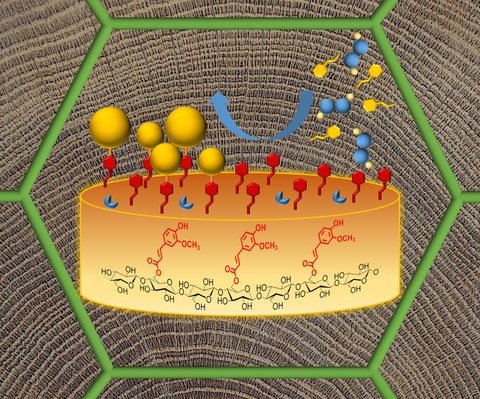Sep 27, 2022
5th EPNOE Junior Scientist Meeting 2022 in Aveiro, Portugal
Thomas Elschner präsentierte auf dem diesjährigen EPNOE Junior Scientist Meeting die neuartige Modifizierung von Cellulose mittels Mitsunobu-Reaktion im Rahmen eines Keynote-Vortrages. Diese hochselektive Synthese führt in einem Schritt zu löslichen Hydroxyzimtsäureestern von Polysacchariden. Modellfilme aus Celluloseferulat eignen sich für QCM-Studien über die enzymatische Polymerisation von Coniferylalkohol [1], ein Prozess wie er bei der Verholzung von Pflanzenzellen abläuft (siehe Grafik). Die Forschungsarbeiten wurden am Institut für Pflanzen- und Holzchemie durchgeführt und gefördert durch die Deutsche Forschungsgemeinschaft (DFG)—Projektnummer 451990883.
Abstract: Highly Selective Mitsunobu Reaction of Cellulose with Hydroxycinnamic Acids
Typical structural motives in plant cell walls are hydroxycinnamates of polysaccharides, e.g. ferulic and p-coumaric acid esters perform cross-linking between lignin and hemicellulose [2]. To design sustainable and bioinspired materials, the understanding and mimicking of lignocellulosic biomass is essential. However, it is very difficult to study structure-property relationships of complex architectures occurring in plant material. Therefore, chemical synthesis of model compounds is a promising approach to discover the secrets of nature.
In this work, cellulose esters of hydroxycinnamic acids were synthesized by Mitsunobu reaction applying triphenylphosphine and diisopropyl azodicarboxylate in N,N-dimethylacetamide/LiCl [3]. This reaction is highly selective and takes place at primary hydroxyl groups at position 6 of cellulose without undesired conversion of double bonds and phenolic hydroxyl groups. The products are soluble in dimethyl sulfoxide and possess degree of substitution (DS) values of up to 0.5. DS values were determined by NMR spectroscopy of peracetylated derivatives and UV spectroscopy of extracted ferulic acid. The synthesis of cellulose hydroxycinnamates is very important to design lignocellulosic model systems and antioxidative bioinspired materials.
[1] T. Elschner et al, Biomacromolecules 2022, 23, 2089−2097
[2] R. D. Hartley, J. Sci. Food Agric. 1972, 23, 1347
[3] T. Elschner et al, Macromol. Chem. Phys. 2021, 2100232

